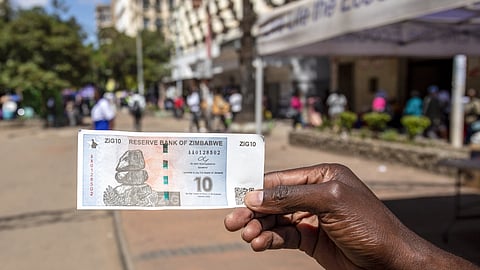All about Zimbabwe’s latest shot at a stable currency: The gold-backed ZiG
Zimbabwe's introduction of the ZiG, a gold-backed currency, aims to stabilize its economy after years of hyperinflation. Launched in April, the ZiG replaces the Zimbabwean dollar, which depreciated rapidly since its 2019 revival. Backed by $100 million in cash and 2,522 kg of gold, the ZiG aims to restore public trust. While still early, authorities are encouraging its use and have seen a reduction in dollar transactions.
Sign up for your early morning brew of the BizNews Insider to keep you up to speed with the content that matters. The newsletter will land in your inbox at 5:30am weekdays. Register here.
Join us for BizNews' first investment-focused conference on Thursday, 12 September, in Hermanus, featuring top experts like Frans Cronje, Piet Viljoen, and more. Get insights on electricity and exploiting SA's gas bounty from new and familiar faces. Register here.
By Alister Bull and Ray Ndlovu
In the latest effort to devise a credible national currency, Zimbabwe in April replaced its dollar with the ZiG, short for Zimbabwe Gold. The new unit is backed by bullion and foreign currency reserves held at the central bank. It's the country's sixth attempt at establishing its own currency since 2008, when inflation crossed 500 billion percent, according to International Monetary Fund estimates. Not only did that render it worthless, it turned the unit into a global punchline: US Treasury secretaries would carry the notes as a reminder of the evils of hyperinflation. Confident that they've finally got it right, Zimbabwe has announced plans to go all-in on the ZiG and make it the southern African nation's sole legal tender. That's an audacious goal, given that the dollar still accounts for the bulk of transactions in the country.
What went wrong with the Zimbabwean dollar?
Brought back to life in 2019 after a decade-long furlough when the country ran solely on foreign currency, the Zimbabwean dollar lost ground against the US dollar every trading day this year. This had wiped around 80% off its value by the time newly appointed central bank Governor John Mushayavanhu put it out of its misery on April 5. The collapse had already forced more than four-fifths of the southern African nation's economy to transact in US dollars for everything from food to medicine, with some businesses only accepting payment in greenbacks. Few people have forgotten the experience of 2008, when their savings were wiped out by inflation, so public trust in the local unit had always been low.
Enter the ZiG
The ZiG started trading on April 8 at an exchange rate of 13.56 to the dollar. Banks, mobile-money platforms, retailers and other intermediaries reconfigured their systems to take account of the new currency, though the process has been a bumpy one. All holders of Zimbabwe dollar accounts had their balances converted to ZiG. The change also affected share prices on the Zimbabwe Stock Exchange, which rebased its 56 listed securities. In June, the International Organization for Standardization registered the unit's code as ZWG at Zimbabwe's request. This ensured it conformed with international standards requiring a currency code to start with the two-letter country code — in this case ZW — and to contain no lower-case letters.
Where does the currency's value come from?
The central bank said the new currency would be fully backed by $100 million in cash and 2,522 kilograms of gold worth $185 million. New banknotes were released on April 30, and the central bank went on a publicity drive to raise awareness of the new currency. To foster demand, Zimbabwe has made it mandatory for companies to settle at least half of their quarterly tax obligations using the new unit. Some taxes may only be paid in ZiG.
Is it working?
It isn't easy to restore confidence in a currency whose predecessors have failed, and it will take some time to assess whether it gains acceptance. But the authorities have been leaning on Zimbabweans to use the ZiG by ordering government services to be paid for in the unit, in addition to the tax requirement. They have also fined traders for refusing to accept payment in ZiG. The authorities say that dollar-denominated transactions have declined to around 70% from 85% when it was introduced. In early August, the cabinet said it had adopted a "dedollarization roadmap" without providing details of when it would take effect, though President Emmerson Mnangagwa has hinted it could happen as early as 2026. Official statistics suggest that the ZiG has helped to rein in surging price pressures since its April launch, though there are only a few months' worth of data to go on.
What explains Zimbabwe's currency chaos?
The southern African country has suffered a succession of economic crises, the near-collapse of government services, runaway inflation and widespread poverty and unemployment. Previous attempts to resuscitate a local currency have failed largely because the cash-strapped government resorted to printing money to fund the budget. Central bank boss Mushayavanhu has repeatedly promised that this mistake will not be repeated on his watch.
Read also:
© 2024 Bloomberg L.P.

